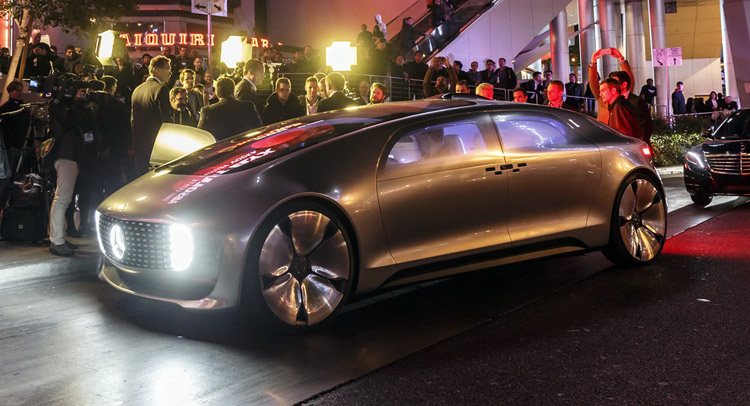The game-changing Mercedes-Benz F 015 concept finally debuted this week at CES 2015 in Las Vegas. According to the same company that invented the conventional automobile when it introduced the Benz Patent-Motorwagen in 1886, the straight-out-of-science-fiction Mercedes-Benz F 015 concept will be our new reality by the year 2030.
“The single most important luxury goods of the 21st century are private space and time. Autonomously driving cars by Mercedes-Benz shall offer exactly that. With the F 015 Luxury in Motion, this revolutionary concept of mobility becomes tangible for the first time,” announced Dr. Dieter Zetsche, the bold and daring Chairman of Daimler AG and Head of Mercedes-Benz Cars.
At first impression, the all-electric 2030 Mercedes-Benz F 015 is unlike anything we’ve ever seen. The carbon-fiber-reinforced-plastic concept car is 40 percent more lightweight than cars today. Its elegant soap-bar shaped design features a bold LED fascia and a stunning diamond-pin grille that we first saw on the Mercedes Vision GT concept, which unveiled at the LA Auto Show.
An interesting windshield swoops over the roof to create an “hourglass”-shape that connects the rear glass. Finally, the striking skipping-stone silhouette is accomplished by a fluidic design exaggerated by translucent side windows that create a mesmerizing monolithic effect. All in all, the Mercedes-Benz F 015 looks like it came right out of “Demolition Man,” the 1993 futuristic dystopian sci-fi thriller starring Sylvester Stallone and Wesley Snipes. Coincidentally, the movie was set in 2032.
If you thought the exterior design looked strange, the interior is downright bizarre. Given that the Mercedes-Benz F 015 is a purpose-built fully-autonomous vehicle, the cabin reveals a staggering variable seating system featuring four rotating lounge chairs that are designed so that passengers could face each other to work, interact, or engage in recreational activities with one another during the commute.
The passengers may also interact with six screens that are integrated to the instrument panel. The passengers can navigate through the screens via gestures, eye-tracking, or good old touch screen technology. The Mercedes-Benz F 015 is designed to offer unprecedented mobile connectivity as well. Should the passengers eventually decide to disable the autonomous system and drive the car manually, the driver’s seat will simply pivot to the steering wheel and pedals in the forward position once the manual driving option is engaged. Finally, the four lounge chairs are also designed to rotate outwards by 30 degrees once the door is open for easier entry and exit from the vehicle.
According to Mercedes-Benz, the all-electric and fully-autonomous F 015 concept is inspired by the growing population of megacities that will inevitably cause traffic congestion to become an impossibly frustrating problem. The F 015 is designed to keep its human occupants productive rather than to endure the arduous task of driving through dense urban traffic. This philosophy effectively makes manual driving an occasional option rather than the primary task inside an automobile. In fact, the translucent side windows even discourages manual driving. The ramifications of this technological trend is not only a legislative landmine, but also a disheartening glimpse into the future.
For the tech advocates at CES 2015, the Mercedes-Benz F 015 represents a dramatic and flawless leap in the evolution of transportation that will effectively remove the human element. However, the idea isn’t revolutionary as autonomous navigation has already existed for decades: commercial flight.
During long transoceanic flights, airline pilots commonly engage autopilot to allow the aircraft to fly along a guided route. However, pilots are still required to take over the controls during critical moments during landing and take-off. In fact, airline pilots must also log hundreds of hours of flight practice before they become fully certified. Finally, in the event of a malfunction, the pilots are still held responsible for their actions and decisions if a crash occurs. When the scenario is translated to autonomous cars, rationale suggests that the person behind the steering wheel of a self-driving vehicle is still ultimately responsible for preventing an accident. As a result, auto insurance claims will most likely still be dealt between drivers when an accident does occur.
However, the fact that the driver seat in the Mercedes-Benz F 015 concept can turn away from the controls to face fellow passengers completely contradicts with common sense. Even worse, it’s also sending a message that society will no longer require a new generation of drivers. Despite Mercedes-Benz’s intent to create this new concept car for densely populated megacities, the natural tendencies of human nature will allow us to take advantage of the convenience even if traffic is nonexistent. Let’s be honest, we would allow shoelaces to tie themselves if they could.
For the few car enthusiasts left on earth, the direction spells an unwelcomed change. Sadly, the potential mainstream popularity of autonomous driving may cause future legislation to accommodate the new technology on the road. In the worse case scenario, future rules and regulations may even discourage humans from driving entirely by taxing individuals that choose to own a car without driver assist computers.
Now it’s your turn: does the Mercedes-Benz F 015 fill you with dread or are you optimistic with the direction the automotive industry is heading? Let us know in the comment section below!
By Danny Choy






































































